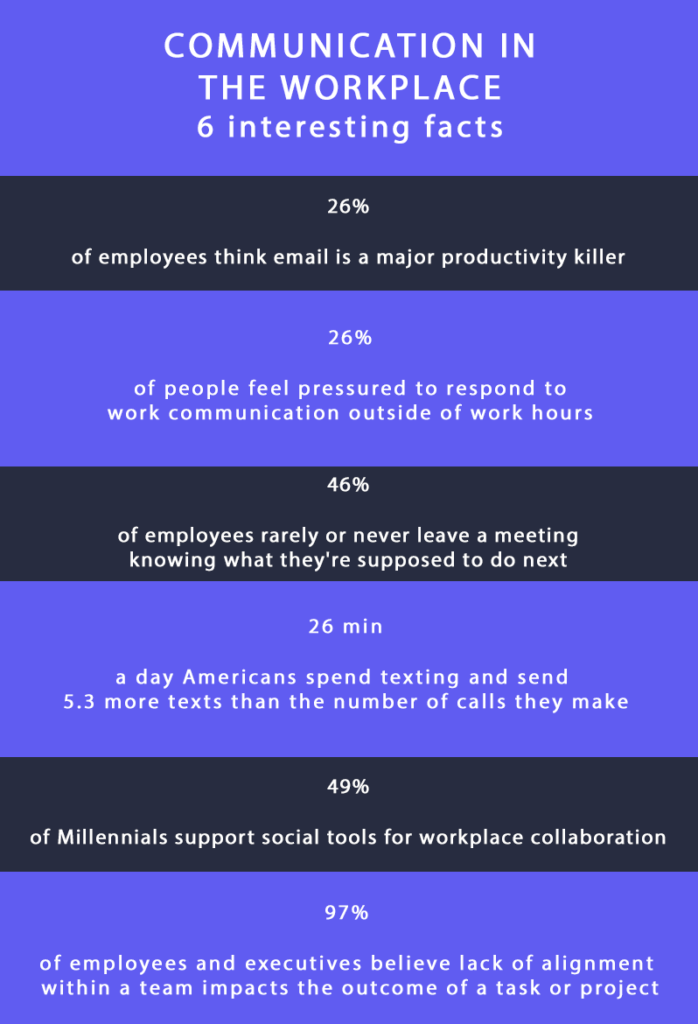Stepsy
How to improve team communication: tips & tools for effective communication in the workplace
Many managers are chasing high KPIs while said KPIs stay low for a simple yet not so obvious reason – poor communication in the workplace. How to improve communication in the workplace in this case? Which team communication tools have proven to be effective? In this article, I’d like to share with you our secrets of effective communication in the workplace. Although our company belongs to those with less than 50 employees, it has more than doubled over the last year, so we do know how to improve communication in the workplace in a fast-developing environment. I’m honestly happy with our workplace communication practices and hope you can employ them similarly successfully in your team!
Faster delivery on any type of documentation
Stepsy automatically captures screenshots with every mouse click and generates text descriptions for each step. Now you can get a detailed step-by-step guide of complex routine procedures without any distractions or manual work

Key drivers of poor team communication
Before reading about practical tips on how to improve communication in the workplace, please check out the 4 most widespread reasons why team communication may pose a challenge.
1. Non-face-to-face interaction
While digital advancement may be increasing the speed and ease of workplace communication in many ways, technology has “displaced” the workforce towards a preference for working remotely – from home or just away from the office. CNBC reported that 70% of professionals today work remotely at least one day a week, while 53% work remotely for at least half of the week. Working remotely creates a culture that supports a flexible working arrangement and is deemed a perk. However, the durable absence of face-to-face communication can result in misunderstandings in the case of poor management and control of workplace communication. Stalled projects, deferred delivery timelines, or post-launch revealed defects can cause problems when employees are working away from the office. Thus, the solution here is to organize communication with the remote team effectively.
2. Poorly written workplace communication
The consequences of poorly written workplace communication can range from moderate to severe. A poorly documented standard operating procedure (SOP) may result in errors during execution, while an erroneous training manual may cause employee frustration. For example, when the team misses launch deadlines, the company may not be able to recoup revenue loss due to the time lost. When the client fails to receive the promised follow up, customers lose faith in the organization and move to its competitor. In this situation, every piece of written workplace communication, be it a message in a chat or a runbook, matters. While the former can be usually remedied in a matter of minutes, when the problems hide in technical documentation, it’s not that easy to find and fix them. That’s why it’s so important for effective communication in the workplace to know how to ultimately create technical documentation.
Read more about:
How to create a runbook that rocks? Automatically is the best way
How to write an SOP: step-by-step guide & SOP template
How to write a training manual: template & instructions
How to build a knowledge base: software & best practices
How to create a user instruction manual: the fullest guide
How to create IT process documentation? Template & tools are everything you need
3. Cultural differences
Today’s workforce is a mix of cultures as organizations are open to hiring not only locals but also expatriates. This is accompanied by the various cultural differences in people from different social, economic, or religious backgrounds. This issue is especially noticeable in the big cities and the more your company grows, the more the culture of its employees diversificate, and the higher the probability of poor communication in the workplace becomes. People sharing similar technical skills may have different cultural backgrounds within a business unit, and cultural differences with regards to work ethics or perception of acceptable working hours can differ. Undoubtedly, this should be regulated with the corresponding corporate culture bonding all employees. Still, without effective workplace communication techniques, this issue creates a cultural divide, and the employees with the same cultural habits tend to form cliques.
4. Attitude and ego
Team members full of pride and ego fail to acknowledge mistakes, attempt to conceal them and over time, even a previously small problem may grow to be an issue of enormous proportion. To achieve effective communication in the workplace, there should be no place for ego – with all members of a team working for the better of the organization in mind, negative attitude and ego should take a side step to prevent team communication problems in the workplace. For this reason, it’s essential to hire employees not only for their professional skills but also for their personal qualities. Offer a job only to those who can work in a team collaboratively, adjust to others’ needs, requirements, and feedback, and understand the value and importance of communication in the workplace.

How to improve communication in the workplace + team communication tools
Recognizing the adverse impact of team communication problems in the workplace, here are 5 steps on how to improve communication in the workplace and the 5 best tools.
1. Communicate with everyone
Team communication tools are popular nowadays and there is no wonder why: they have proved to be the best solution for those curious about how to improve communication in the workplace. There are plenty of tools on the market and you can choose the one that meets your needs in full. Why do you need team communication tools? Indeed, they are extremely convenient and useful, just try them! E-mail, Messenger, or Skype may work for small teams like 5-7 people, if that’s enough for you – stay there. Still, e-mail is usually considered a more official way of communication which is not appropriate for everyday workplace communication between teammates. As for our company, we’ve already found our favourite one and would like to recommend it to you as well.

Recommended tool: Slack
- Connect your team anytime to avoid poor communication in the workplace
- Discuss everything from the important projects to going for lunch
- Communicate with anyone, be it a whole team at once, several employees, or a particular teammate/person
- Integrate the services you use every day to team communication tools
- Search through channels and files
2. Guide your teammates
One of the vital constituents of effective communication in the workplace is in-company knowledge sharing. By this, I mean any workplace communication aimed at showing and teaching an employee how to complete a particular procedure. It can be anything from a simple question in a chat/e-mail or corporate documentation like new employee training manuals, SOPs, runbooks, and others. These elements are vital since they may affect the performance of many people at once. For example, the whole department may use the same instruction manual, and inaccuracies or ambiguity in it will cause problems to the whole department or even negatively impact the work of other teams in the company. On the other hand, if you have ever worked on the creation of such documentation like me and value the importance of communication in the workplace, you probably know that it’s quite a time – and an effort-consuming process. That’s why I’d like to recommend you a software program which would help you create a guide, manual, video tutorial, presentation, and even a knowledge base much faster and easier than ever before.

Recommended tool: Stepsy
- Create & deliver any type of guide faster
- Explain better with screenshots and images
- Delegate tasks and provide your feedback
- Quickly edit and customize your guides
- Export and share using Google Docs
3. Store, share, and collaborate
Another frequent example of workplace communication is collaboration on a project or task. In this case, it can be uncomfortable to use traditional team communication tools such as e-mail or phone. From my personal experience, I know that the most convenient way for me is to use a cloud-based workspace to store all work files. Here, you do not worry about having any changes unsaved or files lost or stored on another device. What’s more important, such workspaces usually allow you to share your files with the team or anyone else and also to work simultaneously on the same files, review them, provide feedback, and so on. In addition, it promotes more effective communication in the workplace since you can even create a knowledge base on a cloud-based workspace and share it with whoever you need to.

Recommended tool: Google Docs
- Store private, team-only, or public files
- Collaborate and distribute tasks easily
- Create a knowledge base using Stepsy and store it on Google drive
- Share your files with team members, partners, customers, mentors, etc.
- Make use of the integration with Stepsy in full: create guides in the form of documents and images
4. Define goals and expectations
Team members must understand, practice and embrace the organization’s goals to deliver the desired result and this is closely connected with effective communication in the workplace. Steering a team without any goals is akin to steering a ship into a treacherous vast ocean without any navigation tools. Team members with clear goals and understanding of the importance of communication in the workplace will forge forward in the right direction and deliver the expectations required by board members. Managers need to play their role by delivering clear, achievable goals to teams and individuals, underlining what needs to be achieved, how it can be achieved, the consequences of not achieving goals and the deadline to achieve them. For our team, regular OKRs (Objectives and Key Results) set using the service described below have become a significant boost for our performance and helped overcome communication problems in the workplace.

Recommended tool: Weekdone
- Visualize the goals hierarchy
- Share and measure the progress of objectives
- Keep up to date on the tasks of your colleagues
- Estimate your team’s status to reveal any communication problems in the workplace, if any
- Stay up to date with teammates’ plans, progress, and issues
5. Clearly set tasks and track them
Undoubtedly, task tracking and management are two of the key goals of team communication tools within any company. The success of the task execution directly depends on the way you communicate it. Even if employees have goals and expectations defined for them, it does not necessarily mean they know how to achieve them. That’s why it’s crucial to set clear and accurate tasks needed for the achievement of the expected results. In addition, even when employees define their tasks without supervision, their colleagues or management can still review and provide feedback on some tasks. This allows keeping everyone’s activities in alignment with general team objectives and preventing poor communication in the workplace. This element of effective communication in the workplace is usually accomplished with the help of special-purpose task management services.

Recommended tool: Jira
- Create user stories and issues
- Assign tasks to your team
- Plan sprints to prevent any communication problems in the workplace
- Prioritize and discuss your team’s work
- Improve employee performance based on real-time, visual data
10 simple ideas for effective communication in the workplace
- Use simple words & be precise
Avoid complex words and phrases when communicating, and speak in easy to understand language with minimal jargon. For effective communication in the workplace, be precise and K.I.S.S. at all times – keep it simple and short!
- Be trustworthy
Treat your team the way you would like to be treated by being genuine. Show them that you will guide them with your wisdom and guide them out of trouble with your experience. Demonstrate that they can trust you and you will have their loyalty.
- Listen and show empathy
Listen attentively, take a step back and look at the problem from another perspective. Show empathy in workplace communication – sometimes a little gesture that acknowledges the challenges they go through can give them the needed strength to power through the challenging moments and deliver the required goals.
- Ask questions
If a team member is afraid of asking questions, it also causes poor communication in the workplace. Be brave enough to ask questions which may seem dumb and encourage others to do the same. It’s better to ask again before doing rather than correcting errors after.
- Always find something positive to say
Team communication should stay positive even if someone is being critiqued. A mistake is always a lesson, it’s just important to not forget to learn it. Make use of the method of sandwich when providing feedback.
- Do not over-communicate
Over-communicating occurs when the same message is repeated multiple times or irrelevant information is introduced. This causes confusion, employee frustration and slows down the execution process. To preserve effective team communication, share only useful information and halt a long text if it does not carry any weight.
- Create a communication-friendly space
If you think of the importance of communication in the workplace, it’s essential to create a communication-friendly space where everyone will feel safe to express their opinions and ideas. No one likes to be judged when they speak, so banish that culture within the workplace communication so that everyone feels accepted and understood.
- Uncover communication problems in the workplace
Remember, your aim is not only to avoid poor communication in the workplace but also to solve existing and prevent potential communication problems in the workplace. Through observation, one-to-one interaction, and employee polls, identify existing communication problems in the workplace. Make sure to resolve them tactfully and swiftly, and offer team communication tools if needed.
- Be ready to help
In this case, if your teammates need a hand in something, be ready to help them. Recommend workable solutions, guide them, and monitor progress for improvement if needed. This will significantly contribute to effective communication in the workplace.
- Learn to say no
Do not be surprised by such a recommendation in this article on how to improve communication in the workplace. If you can’t say no, you will spend your working time helping others rather than yourself. Of course, you should help your teammates, but always estimate the time needed and prioritize your own and others’ tasks to make the right choice.
The importance of communication in the workplace
Effective communication in the workplace can help your business blossom, without it you cannot count on success. Employers that invest time and money to establish clear lines of team communication know the importance of communication in the workplace and aim to ensure that employee’s day-to-day communication is aligned with the organization’s goals. Failure to do so will result in poor communication in the workplace which can lead to disgruntled staff, poor employee morale, an increase in absenteeism, and a decrease in productivity.
Thus, the importance of communication in the workplace cannot be underrated, and here are 4 reasons why strong team communication is so important:
- Voice for everyone
Open team communication supported by corresponding team communication tools creates a transparent work culture where employees are free to express their ideas, praise colleagues who have done a good job, or speak up against those who have abused their power. To build effective communication in the workplace, make it easy for employees to lend their voice through open feedback, polls and surveys, and allow them to rate their superiors. By giving each employee a chance to be heard, the team feels empowered, motivated and at the same time, accountable for their roles and actions.
- Growth
Communication problems in the workplace can come in handy in some cases as they give a chance to deepen your understanding of corporate culture. Workplace communication can be viewed both internally and externally. By ensuring that all levels of the organization are aligned internally with the business goals corporate culture, employees are likely to deliver a consistent message to the external stakeholders like customers or partners. This is particularly important in the service industry where customer experience is crucial.
- Drives innovation
When employees can openly communicate their ideas without being judged or ridiculed, they will be motivated to bring their idea to the table. Communication problems in the workplace, as well as any other issues, can serve as a catalyst to drive innovation as each employee is encouraged to share solutions to the issues, paving a way for new ideas. You can also creatively use team communication tools for this purpose – in some cases, they’re more effective than open discussions.
- Develops strong management and builds teams
Establishing effective communication in the workplace helps build robust management teams. When managers are strong communicators, they are better at delegating tasks, managing conflicts, motivating employees and building positive relationships at all levels. The absence of communication problems in the workplace minimizes employee friction and empowers a workforce that is forward-thinking. On the contrary, poor communication in the workplace creates opportunities for misunderstandings resulting in mistrust, low job satisfaction, and high employee turnover.
